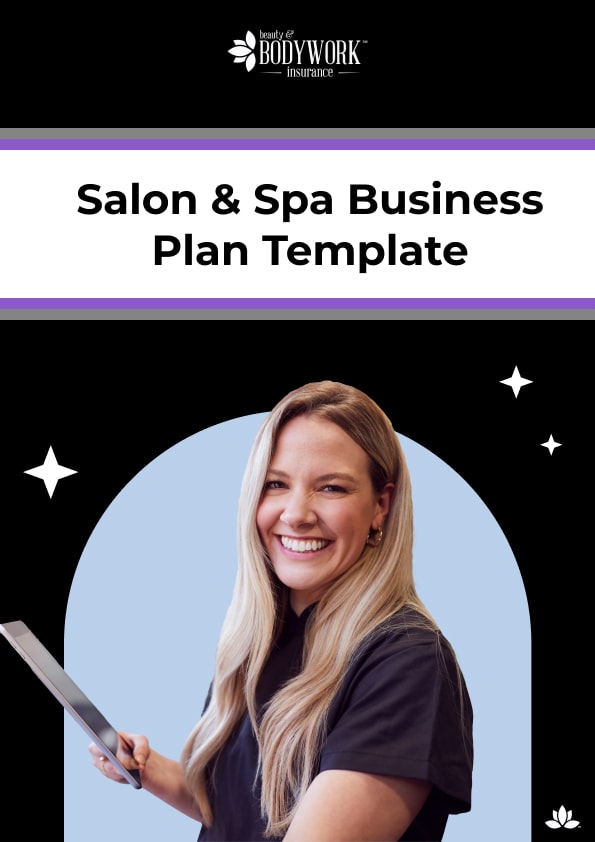You’ve dreamt of opening your own salon and spa, and now you’re ready to make it a reality. Congrats! You’re in for a rewarding journey ahead. Now is the time to prepare your new venture for long-term success with a comprehensive business plan.
Why should you write a business plan? A spa and salon business plan is your playbook—it’s your vision for your company and the steps you’ll take to bring it to life. Developing a business plan will help you outline your goals, strategize, and make informed decisions. It involves thorough research of your target market and competitors, as well as creating effective marketing strategies and assessing finances.
This blog will guide you through nine essential steps to develop a successful salon and spa business plan—whether you’re a hairstylist, an esthetician, a massage therapist, or a cosmetologist. Follow along with our free downloadable template and create your very own road map toward a flourishing business.
1. Start With the Executive Summary
The executive summary is the first section of your business plan. Think of it as a high-level overview of your salon and spa business. It should include a brief description of your business, its unique selling proposition, goals, mission statement, and keys to success.
The executive summary sets the tone for the rest of your spa and beauty salon business plan, so write it concisely and compellingly to grab the attention of potential investors and lenders.
2. Include Your Company Description and History
Why should a potential lender or investor care? This second section dives deeper into what makes your salon and spa unique—such as its services, target clientele, and competitive advantage.
If you’re already in business, you should also highlight your growth and success by including a brief business history. This will enable potential partners or investors to feel confident that you’re a worthwhile venture.
A well-crafted company description and history will help your salon or spa business plan stand out in the industry and give interested parties a clear idea of what your company offers.
3. Perform a Market Analysis
Performing market research provides the context of where your business will fit in. This requires thoroughly examining the current state of the salon and spa industry, identifying your target market, assessing the demand for your services in your area, and doing a competitive analysis to develop unique selling points.
Once you understand your desired clients’ needs, you can identify reasons why they might choose you over your competitors. As you write your spa’s or salon’s business plan, position your business with the insights from your market research, so that your company can rise above a crowded market.

4. Detail Your Services and Pricing
This section enables potential lenders and investors to understand the scope of your provided services and your pricing strategy. It also helps you establish your business in the marketplace and communicate clearly with your customers. Highlight your value by outlining your services and prices—this, in turn, will illustrate how you will make money for your salon and spa business.
5. Explain Your Marketing and Sales Strategy
How will you attract customers and keep them happy? In a salon or spa business plan, this section outlines your methods for getting customers interested and generating sales. It should provide details on the target market’s psychographics and demographics, as well as your marketing strategies for engaging with them.
This can include initiatives, such as collaborations, social media marketing, partnerships, advertising, and promotional activities—all the ways you plan to raise awareness and acquire customers.
The sales plan should also detail pricing strategies, like bundles or discounts, and establish referral or loyalty programs to encourage repeat business. Ultimately, a salon or spa business must leverage thoughtful marketing and sales strategies for continued success.
6. Outline Your Operational Plan
Mapping out your daily operations, including opening hours, staffing, and service processes, allows potential lenders to envision your spa and salon business functioning at its best. It also ensures you have thought through the small details that can make or break your business.
In this section, you can also include information about your suppliers and a description of your facility to round out your operational plan. You’ll also need to think through operational needs, like:
- What client scheduling software to use
- Which types of salon insurance you’ll need
- The payment processing tools that will best fit your needs—and more.
7. Highlight Your Management Team and Organization
Your management team plays a vital role in the day-to-day operations of your business, and investors want to know that you have a skilled and experienced team in place. In this section of your spa and beauty salon business plan, you must provide details about each management team member, including their responsibilities, credentials, areas of expertise, and previous work in the salon and spa industry.
You should also touch on your current and future staffing needs in this section. By showcasing your management team’s skill level and by forecasting employee organization, you will show investors that you have the necessary leadership to manage and grow your salon and spa business effectively.

8. Present Your Financial Projections
Now it’s time to talk numbers. Your salon and spa business plan must include financial projections, which examine the financial health and anticipated profitability of the company. It outlines startup costs, a timeline for estimated income, expenses like salon and spa equipment and insurance, and a cash flow forecast.
Lenders and investors can determine your company’s viability based on these forecasts. It also helps you establish realistic financial objectives and create plans for success. Financial predictions are essential in proving the company’s financial viability and potential for growth in a spa and beauty salon business plan.
9. Finish With an Appendix
The final piece in a business plan for salons is the appendix, which provides additional details and supporting documentation. It includes market research data, financial forecasts, résumés of key employees, and other pertinent details that give your plan more substance and credibility.
By including an appendix, potential investors or lenders can learn more about the intricacies of your salon and spa business, increasing the professionalism of the plan and the likelihood of receiving backing for the endeavor.
Why Writing a Salon and Spa Business Plan Is Important
Writing a salon and spa business plan is crucial for several reasons. It helps you define your business goals and objectives, outlining the direction of your salon or spa. It creates a clear road map for success and guides your decision-making process.
A well-written spa or beauty salon business plan can also secure funding from investors or lenders, showcasing your professionalism, salon marketing plan and market knowledge, and potential for profitability.
Moreover, it is a valuable tool for monitoring progress and making necessary adjustments to ensure long-term success. Even if you’re not seeking funding, thoroughly thinking through every aspect of your business ensures nothing critical is overlooked as you grow.
Now that you know how to write a successful spa and salon business plan and why it’s important, it’s time to get started on yours. Use our free downloadable template below and lay the groundwork for the business you envision!
FAQs About Writing a Salon and Spa Business Plan
What Is a Salon and Spa Business Plan?
A salon and spa business plan outlines goals, strategies, and financial projections. This plan serves as a road map for entrepreneurs and stakeholders, providing direction for growth and success. It includes sections on market analysis, target customers, competition, marketing strategies, services, operations, and finances. It addresses factors like location, staff, pricing, and revenue.
Why Should I Write a Salon and Spa Business Plan?
A salon and spa business plan is crucial for success in the beauty and wellness industry. A well-developed business plan is essential for funding, attracting investors, and guiding operations. Even if you’re not seeking funding, it ensures no critical aspects of your business are overlooked.
What Is the Business of a Spa?
A spa is a business that offers relaxation and rejuvenation services to consumers – massage therapy, facials, body treatments, and other health services like yoga or meditation sessions. The goal of a spa is to create a calm and pleasant atmosphere where clients can relax and take care of themselves, away from the stress of daily life.
What Is the Business of a Salon?
Salons provide beauty services to clients – manicures, pedicures, facials, waxing, haircuts, styling, coloring, and treatments. Salons often offer additional services like body treatments, massages, and cosmetics applications. The main goal of a salon is to enhance customers’ appearance and overall well-being, helping them to look and feel their best. Some salons also sell beauty supplies that customers can purchase and bring home.








